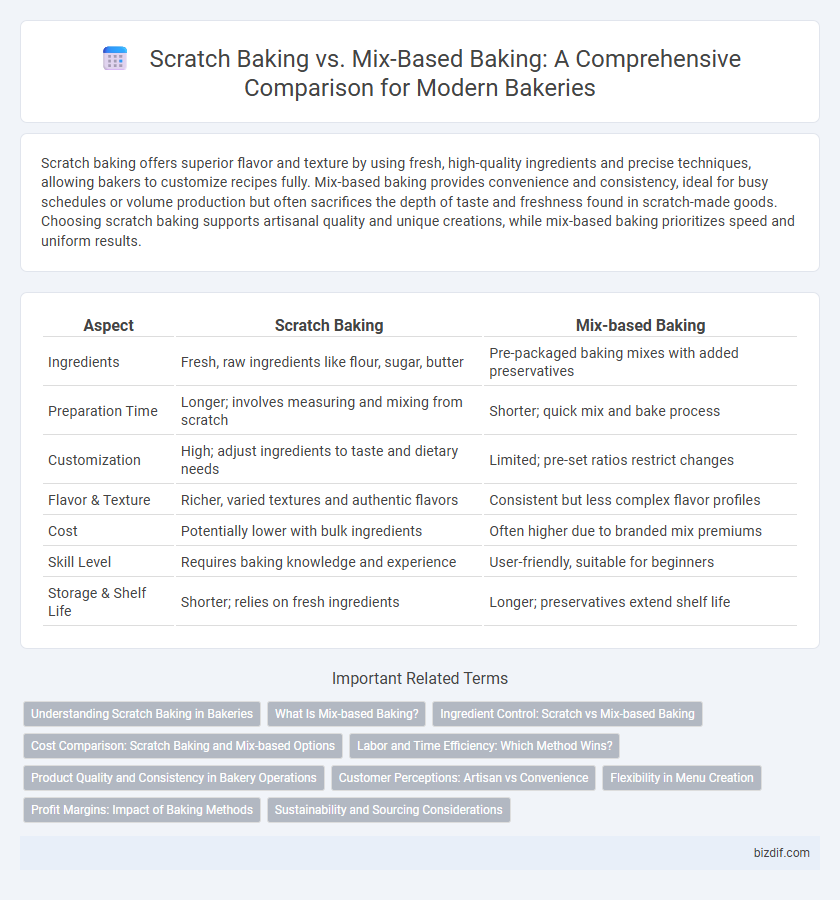Scratch baking offers superior flavor and texture by using fresh, high-quality ingredients and precise techniques, allowing bakers to customize recipes fully. Mix-based baking provides convenience and consistency, ideal for busy schedules or volume production but often sacrifices the depth of taste and freshness found in scratch-made goods. Choosing scratch baking supports artisanal quality and unique creations, while mix-based baking prioritizes speed and uniform results.
Table of Comparison
| Aspect | Scratch Baking | Mix-based Baking |
|---|---|---|
| Ingredients | Fresh, raw ingredients like flour, sugar, butter | Pre-packaged baking mixes with added preservatives |
| Preparation Time | Longer; involves measuring and mixing from scratch | Shorter; quick mix and bake process |
| Customization | High; adjust ingredients to taste and dietary needs | Limited; pre-set ratios restrict changes |
| Flavor & Texture | Richer, varied textures and authentic flavors | Consistent but less complex flavor profiles |
| Cost | Potentially lower with bulk ingredients | Often higher due to branded mix premiums |
| Skill Level | Requires baking knowledge and experience | User-friendly, suitable for beginners |
| Storage & Shelf Life | Shorter; relies on fresh ingredients | Longer; preservatives extend shelf life |
Understanding Scratch Baking in Bakeries
Scratch baking in bakeries involves using raw ingredients like flour, sugar, eggs, and butter instead of pre-made mixes, allowing for greater control over flavor and texture. This method requires precise measurements, skillful mixing, and often longer preparation times to ensure freshness and quality. Bakers can customize recipes to accommodate dietary preferences and create unique, artisanal products that distinguish their bakery in a competitive market.
What Is Mix-based Baking?
Mix-based baking utilizes pre-prepared ingredient blends that simplify the baking process by combining flour, leavening agents, sweeteners, and sometimes fats or flavorings into a single package. These mixes ensure consistent results, reduce preparation time, and minimize measurement errors, making them ideal for both beginners and commercial bakeries seeking efficiency. Common examples include cake mixes, pancake mixes, and cookie mixes, which typically require only the addition of wet ingredients like eggs, water, or oil.
Ingredient Control: Scratch vs Mix-based Baking
Scratch baking allows full control over the quality and quantity of ingredients, enabling bakers to customize recipes to meet specific dietary needs or flavor preferences. Mix-based baking relies on pre-measured ingredients, which limits flexibility but offers consistency and convenience for mass production. Ingredient control in scratch baking results in fresher, often healthier baked goods with the ability to adjust sugar, fat, and flour types precisely.
Cost Comparison: Scratch Baking and Mix-based Options
Scratch baking often involves higher initial costs due to purchasing raw ingredients like flour, sugar, and yeast in bulk, but it allows for better control over ingredient quality and customization. Mix-based baking usually offers lower upfront expenses and saves time by using pre-measured ingredients, though it can result in less flexibility and potentially higher ongoing costs from buying branded mixes. Evaluating cost-effectiveness depends on factors such as batch size, ingredient sourcing, and labor efficiency within the bakery operation.
Labor and Time Efficiency: Which Method Wins?
Scratch baking demands more labor and time as it involves measuring, mixing, and preparing raw ingredients from the beginning, often leading to longer prep and cleanup times. Mix-based baking significantly reduces labor and time by providing pre-measured ingredients, allowing faster preparation and consistent results. For bakeries seeking efficiency and quick turnaround, mix-based baking generally wins in terms of labor and time savings.
Product Quality and Consistency in Bakery Operations
Scratch baking in bakery operations offers superior product quality by using fresh, high-quality ingredients, resulting in richer flavors and better texture compared to mix-based baking. Consistency can be more challenging with scratch methods due to variables like ingredient variations and human error, while mix-based baking ensures uniformity and predictable outcomes through standardized pre-mixed components. Balancing the artisanal quality of scratch baking with the consistency benefits of mix-based approaches is crucial for bakery businesses aiming to satisfy diverse customer preferences.
Customer Perceptions: Artisan vs Convenience
Customers often perceive scratch baking as a hallmark of artisan quality, valuing the freshness, unique flavors, and handcrafted nature of products made from scratch. Mix-based baking is commonly associated with convenience and consistency, appealing to those who prioritize quick preparation and reliable results. The artisan vs convenience perception strongly influences customer preferences, with many willing to pay a premium for the authenticity of scratch-baked goods.
Flexibility in Menu Creation
Scratch baking offers unparalleled flexibility in menu creation by allowing bakers to customize ingredients, flavors, and textures to meet unique customer preferences and dietary needs. Mix-based baking, while convenient and consistent, limits variation as recipes rely on pre-formulated blends with fixed components and proportions. This flexibility in scratch baking supports innovation, seasonal offerings, and specialization, essential for artisan bakeries aiming to differentiate their product range.
Profit Margins: Impact of Baking Methods
Scratch baking requires higher initial ingredient costs and longer labor time, which can reduce profit margins despite superior product quality. Mix-based baking lowers labor and ingredient expenses by using pre-formulated blends, increasing operational efficiency and profitability. Bakeries must balance ingredient quality and production speed to maximize profit margins effectively.
Sustainability and Sourcing Considerations
Scratch baking utilizes raw, minimally processed ingredients sourced locally, reducing carbon footprint by minimizing transportation and packaging waste, thus promoting sustainability. Mix-based baking relies on pre-packaged mixes often produced by large-scale manufacturers, which can involve higher environmental impact due to ingredient processing and longer supply chains. Choosing scratch baking supports transparent sourcing practices and the use of organic or fair-trade ingredients, aligning with eco-friendly and sustainable bakery operations.
Scratch Baking vs Mix-based Baking Infographic

 bizdif.com
bizdif.com